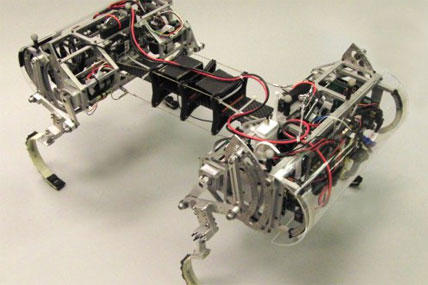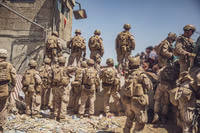ABERDEEN PROVING GROUND, Md. -- The U.S. Army envisions a future where robots are integral members of the team performing autonomous actions and maintaining current capabilities.
Five years ago, the U.S. Army Research Laboratory set out to pursue this vision by forming the Robotics Collaborative Technology Alliance. It sought partners in industry and academia to explore technologies required for the deployment of future intelligent military unmanned ground vehicle systems ranging in size from man-portables to ground combat vehicles.
"The future for unmanned systems lies in the development of highly capable systems, which have a set of intelligence-based capabilities sufficient to enable the teaming of autonomous systems with Soldiers," said Dr. Jonathan A. Bornstein, chief, Autonomous Systems Division for ARL and the collaborative alliance manager. "To act as teammates, robotic systems will need to reason about their missions, move through the world in a tactically correct way, observe salient events in the world around them, communicate efficiently with Soldiers and other autonomous systems and effectively perform a variety of mission tasks."
The paradigm shift is taking robots from being a tool to being a teammate, Bornstein said.
"One example might be a small unit with a search and cordon mission," he said. "One of the things it would have to do is conduct surveillance on all exits of a building. Who is coming out and where are they going? It's a simple question. If I had a squad today, I would send a Soldier to an observation point and just say, 'Tell me who comes out the back door.'"
What Bornstein described is the capstone scenario researchers in the alliance set their sights on when they began the project in 2009. Today, they are almost there.
"We're not as far advanced as we would like to be. You have to have a stretch goal. If you don't, you won't strive to get there. But, we'll do something along those lines," he said.
The Robotics Collaborative Technology Alliance, or RCTA, brought together ARL researchers and eight industry and academic partners:
• Boston Dynamics
• Carnegie Mellon University
• Florida State University
• General Dynamics Robotic Systems
• Jet Propulsion Laboratory
• QinetiQ North America
• University of Central Florida
• University of Pennsylvania
Earlier this year, ARL extended the alliance until April 2020; however, Boston Dynamics, which was recently acquired by Google, will not continue as a member.
"Clearly, collaboration is at the heart of the RCTA program," Bornstein said. "Great progress in fundamental research can be achieved by bringing together researchers who have not previously worked together -- as well as by fostering further collaboration among those who have. We need to engage academia and industry so we can get the best possible product. We leverage people to work on problems of importance to us. If we don't get out there and interact with people, they will drive the train in perhaps a different direction, and we won't benefit from it."
So far, the RCTA has provided many benefits to Army research. Scientists are advancing adaptive tactical reasoning; focused situational awareness; efficient proactive interaction with humans; safe, secure and adaptive movement; and enhanced robotic interaction with the physical world, Bornstein said.
Researchers anthropomorphically describe these capabilities as think, look, talk, move and work.
"Currently, there are major technical barriers which lie in the way of this vision," Bornstein said. "At the heart of the problem is the need for a world model, which can be instantiated on robots and which represents the range of entities, spatiotemporal scales, and abstractions that must be reasoned about. There is also a shortcoming in a robot's ability to sense the environment and understand it at a semantic level; this ability is needed in order to populate the world model with new and relevant information. Robots have only a rudimentary capability to plan behavior, and their planning is focused almost entirely on navigation and is brittle even in that limited domain."
Brittleness is one problem that Army researcher Chad Kessens is tackling, with help from multiple RCTA collaborators.
"While taking an Army training course, I learned that one major problem Soldiers face in the field is that the robot sometimes tips over," Kessens said. "After looking further into the problem, I set out to develop a set of algorithms that would enable any robot to self-right, and several RCTA members also became interested."
Kessens, who is working toward his doctorate, said the Army needs solutions to maintain battlefield superiority and to provide maximum protection to Soldiers.
"The CTA provides a foundation to facilitate top researchers from disparate fields to coalesce around these problems and find solutions," he said. "It's fun to be a part of that.
Fellow ARL roboticist Jason Pusey is working on a unique autonomous quadruped robot called Canid, whose torso consists of a parallel actuated flexible spine.
"This research is being studied collaboratively between ARL and University of Pennsylvania and we are beginning to work with University of California Santa Barbara on more sophisticated controller methodologies."
In the past, quadrupedal robotics all possessed rigid spines. Only until recently has Boston Dynamics and MIT developed a quadrupedal robot with a non-rigid spine.
"The difference between my research and Boston Dynamics and MIT is that I am investigating not only including an actuation mechanism within the spine, but also a flexible element to capture the energy imparted into the robot on each gait cycle and recycle this energy back into the next gait."
Pusey said the robotics alliance is an "exceptional program."
"This program was created to bring as many of the best minds together, and collaboratively strive toward making the future robotics a reality," he said.
Bornstein looks to the future with hope.
"A lot of things that you might think are impossible, if you go far enough down the road, it will become possible. But right now I'm grounding myself in what I think is in the realm of the doable within the next 50 years," Bornstein said. "This is a research program, not a development program. It's basic and applied research. ARL is really focused not on the next system, but the system after the next system. This is really laying the foundation."



























